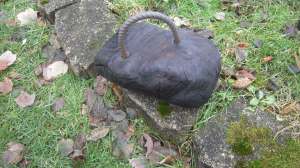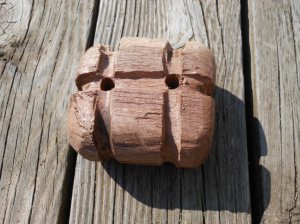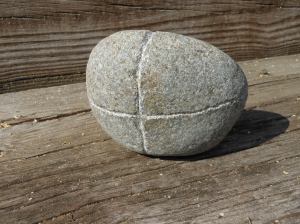One of my sekimori ishi sculptures has been accepted for the Regional Arts Exhibition of this years Festival of the Arts in Grand Rapids. The juror for 3D works was Lindsay Isenhart. The work and other local art work can be seen at the Woodbridge Building in downtown Grand Rapids, Michigan from June 2 to July 15, 2017.
Magnetism and Mysticism
The Pedvale Open Air Art Museum lies in a magnetic field. The magnetic force lines of this field interact with the large granite and iron sculptures to create some unusual magnetic effects. The lifting ring

This is the cast iron ring. The bolts run through the base, then through an oval hole in the upper arms, then directly into the stone.
Plaster Creek Sculpture Trail
This is a proposal for a new site for public sculpture in Grand Rapids, Michigan. The proposed sculpture trail will be entirely on land owned by the city of Grand Rapids, bounded on the east by Kalamazoo Avenue, the north by Plaster Creek, the west by Ken-O-Sha Park, and the south by 32nd Street SE. Map
The proposed trail will be primarily for the viewing of public sculpture, but will also serve as protection for the floodplain of Plaster Creek. Kenosha Drive itself could also be used as an extension of the Plaster Creek Trail. This will re-purpose unused city-owned land, and add to the value of the surrounding community.
Similar sculpture parks or trails in other communities include Sculpture Trails in Solsberry, Indiana, Josephine Sculpture Park in Shafer, Minnesota, Jeske Sculpture Park in Ferguson, Missouri, and Sculpture Fields at Montague Park in Chattanooga, Tennessee.
The first sculpture pad could be sited at the north corner of Kenosha Drive and Kalamazoo.
Tannate Patination of Iron
Tannic acid patination is an ancient technique for forming a dark protective coating on iron objects. It may have been discovered accidentally, after iron objects were lost or buried in peat bogs, then recovered later in an unrusted condition. Iron Age bog bodies have been found with intact iron blades, more than a thousand years old. (reference for iron preservation in bogs)
The process itself is simple and non-toxic. Before starting, be sure that your object is clean, free of grease and oil, and lightly rusted. Japanese swordsmiths would boil their iron Tsuba in wood ashes (lye), then wash them in vinegar, and toast them over a Hibachi to rust. Place the object in a container, and cover it with bark pieces. Add water or vinegar to cover the object and the bark. This should then be allowed to sit for several weeks, to develop the coating. Ideally, the water should be free of chloride, so water that has passed through most water softeners is not acceptable. Distilled or de-ionized water will work well. You can use rain water, but some rain water contains a small amount of chloride, which you want to avoid. If you have a municipal water supply, they may be able to tell you the chloride content of your water. (analysis of Grand Rapids, Michigan water)
As with any chemical process, heat will speed up the reaction. Small objects can be boiled with bark, or the container can be put outdoors in a sunny location, depending on the climate and weather. click here to see a small iron sculpture, which was processed by heating with bark and water in a slow cooker The tsuba on Japanese swords were traditionally boiled in pomegranate peels to darken the iron. patination of iron tsuba
Lowering the pH of the solution with an acid will also speed up the process, but do not use muriatic acid, which is hydrochloric acid, as this adds undesirable chloride ions. Chloride will lead to destructive corrosion of the iron. An organic acid, like vinegar, will work. Phosphoric acid is found in some rust removers. This may add a blueish cast to the patina.
I have fermented the residue from jelly making, which contains some sugars and organic acids. This will form some alcohol, which can be further fermented to acetic acid. Strain out the liquid, and add it to the bark. The resulting solution was quite dark, probably due to some water soluble plant pigments.
Large objects can be painted with a solution, as recommended by the Canadian Conservation Institute. CCI bulletin
MATERIALS LIST
1. WATER You need water with as little chloride as possible. If you can, use distilled or de-ionized water. Rain water may be acceptable. Do not use water from a water softener that uses salt.
2. TANNIC ACID This is actually a mixture of organic compounds. You can buy tannic acid. Tannic acid is contained in tree bark, tea, hops, sumac fruits, black walnut or pecan hulls, and pomegranate peels. You can leave these in the solution while the patina develops. They will eventually have to be replaced. Any hardwood or softwood bark will work, but oak or cherry are particularly nice. Solutions of cherry bark may be toxic. Bark mulch from a garden supply place is sufficient. Logwood contains tannins, and may be available where supplies for trappers are sold.
3. PHOSPHORIC ACID You can buy this on Amazon, or maybe in a local drug store. Coca Cola and other soft drinks may contain phosphoric acid.
4. Other ACIDS Ideally, your solution should have a ph of 2. Distilled white vinegar works. Avoid muriatic acid, which is hydrochloric acid.
5. Homemade vinegar. Anything with sugar can ferment to alcohol, which can be further fermented to vinegar. If this does not occur spontaneously, see if you can get organic vinegar which contains “mother of vinegar” to add to the solution. Try fermenting fruit pulp or peels, beets, carrots, molasses, or anything else that you can find containing sugar. Fruits usually contain other useful organic acids as well. Since you are not going to eat or drink this, spoiled or rotten fruit is fine. Add yeast, and let sit a week or so before straining for use. Allow room for expansion.
6. If you have access to a silo, the drainage contains organic acids, and often alcohol as well. This can be used as the liquid in your patina solution.
7.Alcohol. Alcohol acts as a solvent, and helps the solution to penetrate cracks and porosities in the cast iron. It isn’t strictly necessary, particularly if you are fermenting fruits to produce the material.
Casting a paper wasp nest
Paper wasps build nests using fibers to form a paper like substance.
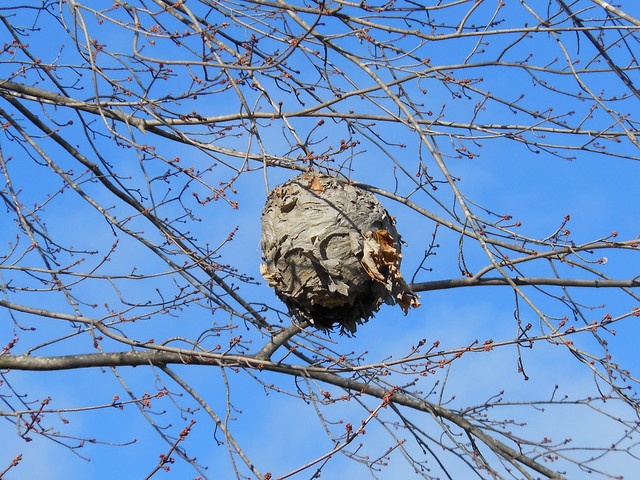
Inside, they look like this:


I made some foam and paper sprues

and attached them to the nest fragments with masking tape:

These were packed in loose sand (shake gently while doing this).
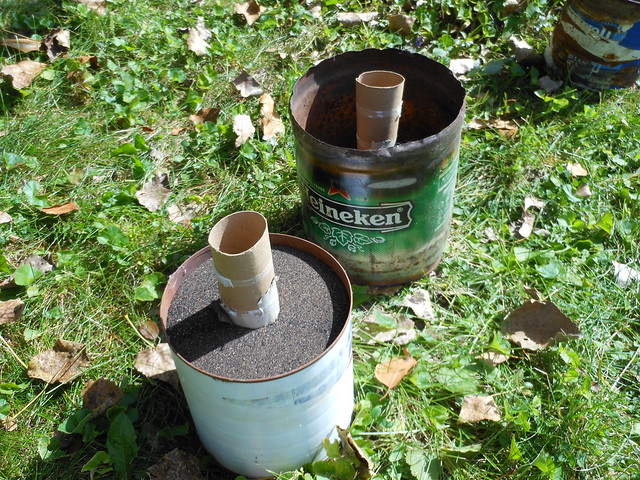
The molten aluminum was poured in the sprues.
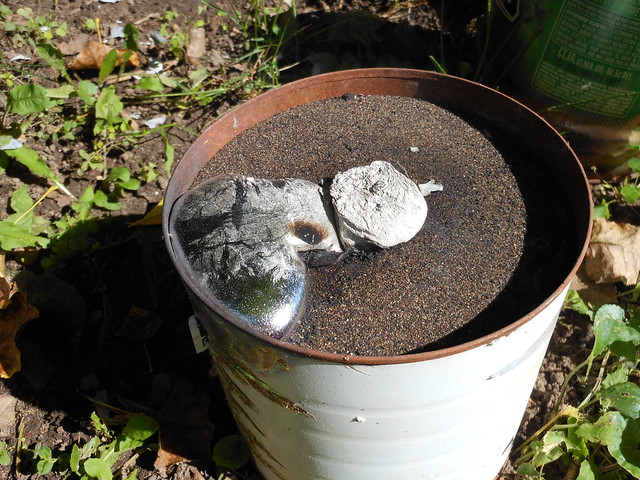
This is the resulting rough casting:

The evolution of Sekimori Ishi
This sculpture was inspired by a trip to the Chicago Botanic Garden, where I saw a sekimori ishi. I was intrigued by a symbol that meant “don’t go here”, which also included a convenient handle, that that could be used to move it out of the way.
The next step was to recreate the form. I had a nice, small piece of walnut, which I grooved and drilled.
I covered the grooves with masking tape and cardboard, and taped on a sprue, then buried this in loose sand, and poured in molten aluminum.
The result was this. Note that it did not quite fill completely.
The next step was to try it in granite. It was fairly difficult to cut the grooves with a carbide wheel.
This was also taped, and a sprue added.
This also worked fairly well. It did fill, but had a hot tear.
The next step was to scale up the process. This a was done with a larger piece of honey locust wood, done the same way that the walnut piece. It was accepted in a local show, where it sold.
I didn’t want to spend hours cutting grooves in granite, so I decided to make a foam cage around a stone. The lifting ring is based on industrial lifting rings.
This was invested in masking tape, and the peice was placed upside down in loose sand, and cast in aluminum.
It filled, with no hot tears.
I really wanted to do one in cast iron. I had been planning to go to the 7th International Conference on Contemporary Cast Iron Art, and I got a call for artists. I entered the piece above as a maquette. My proposal was accepted, but they wanted it bigger than I had planned, and it looked like it would be impossible to cast the iron in one piece around the stone. Before I went to the conference, I did one more in aluminum, with a lifting ring only. This was carved in foam, fitted to the boulder, cast, then glued in place.
I finally did get to make the cast iron version for Pedvale.
I would like to continue with this theme. There are a few possibilities. I have heard of obsidian boulders in Iceland, and I may try to get one. In the meantime, I am looking for a bread loaf size lump of glass to experiment with. I may just cut a slot in the stone or glass, and expoxy a lifting ring in place. The ring does not have to be cast, but could be cut from steel or titanium using a plasma cutter or a water jet.
I have found other artistic depictions of sekimori ishi. This one was done in ceramic in France.
Sekimori Ishi Modern was an exhibit in the Netherlands.
What is the meaning of Seshimori Ishi ?
My sculpture was based on the traditional Japanese sekimori ishi. Here is a photo of one in use in a Japanese garden.
I am interested in visual symbols, particularly ones that may convey multiple meanings.
Sekimori ishi means boundary guard stone. It tells you that a path is closed, but also provdes a convenient handle for moving the stone, so that you can ignore the message. It is not a “Keep Out” sign, but is more of a polite suggestion. The tea master Rikyu is said to have used it as a metaphor for “stay on the right path in life”.
This is a symbol that contains its opposite, much like Nabuo Sekine’s Mono Ha sculpture, Phase-Mother Earth at Suma Rikyu Park.
http://www.nobuosekine.com/image/phase-mother-earth-1968/
The idea behind the sculpture was to include multiple opposites, in addition to this implied restriction and permission of the object itself. The boulder is natural and unworked, while the iron is man made and cast. The upright stone is male, but the rounded form with the ring is female. The boulder is positive space, the iron encloses negative space. Yin and yang. Hot iron and cold stone.
The design of the iron is based on my youth in Pittsburgh. This engraving shows my neighborhood a century before I was born. I grew up playing on coal mine dumps, and there were coal mines under my neighborhood. I got to see lots of early ironwork, some of it in the form of machinery that still worked for decades. My neighborhood was on the third hill from the river.
You can view this sculpture as my desire for you to stay on the right path. As it mimics the aesthetics of 19th and early 20th century iron, it can also mean that you should avoid the excesses of 19th century industrialization and capitalism, or not, as you wish.
Other Interpretations
Other viewers have other ideas of what the sculpture means. Possibly due to Mylie Cyrus, some view it as a wrecking ball. I deny this, and the design was started before her video. On the other hand, if you make a wrecking ball video or photo using this sculpture, please send me a copy.
Several people have seen this as a kraken, devouring the rock. Although octopi have eight tentacles, and squid have ten, I can see this visually.
kraken tattoo design by Iryne R
Uther people have suggested that this looks like an ancient anchor. Anchors are a traditional symbol of hope, so I enjoyed this idea. After the sculpture was made, I found this large buoy anchor in Latvia.
Carol Johnson has written that this reminds her of a bell. I have cast bells, although they have been much smaller than this. I would not want to try to ring it. What is the sound of one boulder ringing?
Making Sekimori Ishi at Pedvale
My plans changed a bit from the initial proposal, which was to cast iron directly around the granite. See my previous post about cultural resource management, and choosing the stone. I could not have completed this sculpture without the help of my assistants, Sutton Demlong and Justin Playl. Both were highly recommended by Tamsie Ringler.
Art in Real Life in Latvia
This is one of my favorite pieces at this years conference:
No, It isn’t a work of Andy Goldsworthy, but the Pedvale team stacking firewood for the winter. Click on the link below to see.
They did several of these while we were there. Click on twin peaks.

